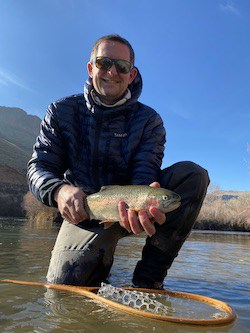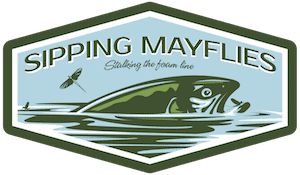The Best Fly Fishing Forceps and Hemostats
July 8th, 2022
Fly fishing forceps and hemostats are must-have items in any fly angler’s gear. It’s actually irresponsible not to carry these vital tools. Always keep them handy when you’re angling.
In the below article, I’ll explain to you why forceps are so important as fishing tools, what they’re used for, what the difference is between forceps and hemostats, and the best forceps/hemostats that I’ve used after thousands of hours on the water.

Here’s a picture of an elk hair caddis fly pattern I’m about to remove from a big brown trout (Salmo trutta) using some fishing forceps.
What are Forceps and Hemostats used for in Fly Fishing?
In fly fishing, forceps and hemostats are used to quickly and efficiently remove fly hooks from the jaws and throats of fish. Due to their slender and precise construction, they can reach and safely remove even the tiniest of fly patterns.
Fly fishing is a bit different than conventional fishing in that our flies are usually much smaller than standard lures and jigs. The smaller the hook, the more exact you must be in removing it from the fish.
If you’re casting size 20-24 dry flies (or nymphs), you need a precise instrument available in case the hook gets lodged deeper into the fish’s mouth or throat (or if you have thick fingers). That’s where forceps and hemostats come into play.
Personally, I’d estimate that I only have to use my forceps for every 20th trout (or fish) that I catch. But when you need them, you really need them. It’s often a life-or-death situation for the fish.
This is why I said earlier that it’s actually irresponsible not to carry these tools with you on the water. Forceps and hemostats can absolutely make the difference between a fish living or dying.
Long shanked forceps and hemostats allow for the quick removal of hooks, which helps keep the fish out of the water a minimum amount of time, and allows for the relatively harmless removal of the fly.
If a fish you catch starts bleeding, which occurs when the hook gets anywhere near their gills, it’s very unlikely the fish will survive.
One study done on the efficacy of hook removal showed that panfish had the best survivability amongst the game fish tested.
Here’s the same trout pictured above, after I quickly removed the fly from its jaws.

Forceps vs Hemostats
All hemostats are forceps, but not all forceps are hemostats.
Let me explain.
Forceps are much like pliers, opening and closing as you open and close your fingers.
Hemostats are forceps, but they have a locking mechanism which is called a ratchet. The tighter you squeeze, the harder the ratchet will clamp down and lock.
I’m not going to lie–once in a while the locking feature is annoying, in that they’ll lock when you don’t necessarily want them to lock.
Hemostats are sometimes called “hemostatic forceps.”
So, to reiterate, forceps open and close. Hemostats are simply forceps that open and close, but can also lock in the closed position.
Here’s a picture of one of my fly fishing forceps with some descriptions of the various components. The eye-clearing needle pokes out any paint or glue that’s covering the eye of the hook, so you can push your line through.

The Best Fly Fishing Forceps/Hemostats
I’m on the water 80+ times each year, and I’ve used plenty of forceps, hemostats, and pliers to remove flies from innumerable fish mouths.
The best fly fishing forceps I’ve found are hemostats (remember, hemostats are forceps, but they have locking mechanisms as well). My all-time favorite are the Rogue forceps by Loon Outdoors, pictured below.
Coming in at a close second are the Rogue quick draw forceps, also by Loon Outdoors.
Both are made of high quality stainless steel, both have a locking feature (making them “hemostatic” forceps), and both have really tough but comfortable handle grip material.
But, there are a few reasons why I prefer the standard Rogue forceps over the quick draw version.
The standard Rogues are just a little less bulky, being 5.5″ in length vs 6.25″ in length, and a bit lighter.
I like the long jaw length of the standard Rogue. The Rogue quick draw has a shorter jaw length, and a scissors feature (which I’ve actually never needed once on the water).
The regular Rogue also has a better eye-clearing needle than the quick draw version.
And finally, I like the finger rings better on the standard Rogue. I do like the caribiner feature of the Rogue quick draw, but I find the considerably larger handle just a bit clunky. This boils down to personal preference.
Both are excellent, top of the line forceps.

How do You Attach Forceps to your fly fishing Vest?
You can attach forceps to your fly fishing vest or gear using one of two primary methods. The first is using the caribiner feature on the handle of many available forceps. The second is by using “hemostatic” forceps, also known as hemostats, which can literally be clamped-down upon almost any piece of your gear.
Once your hemostats are locked into place on your vest or sling pack, nothing’s going to tear them off.
Speaking of important fly angling gear, don’t miss my article on the best fly fishing floatant and how to use it.

Here’s a picture of a large brown trout (Salmo trutta) that I caught on a tiny size 22 dry fly in early spring. Forceps come in very handy in these types of situations, especially when your fingers are cold and the fish has sharp teeth (like browns).
Be sure to check out my article on fly fishing tactics for brown trout.
Summary
I hope I’ve been able to convince you that you need to have forceps and/or hemostats with you at all times when you’re fly fishing. The moment you exclude them from your gear, you can be sure you’ll end up needing them.
Not only will a good pair of forceps save many of the fish you catch over time, they’ll also save you plenty of flies. Rather than repeatedly pulling and tugging at the feathers and hairs, one quick and clean grasp of your forceps will safely remove the hook and your fly pattern.
In my humble opinion, the best forceps for fly fishing are the Rogue series made by Loon Outdoors.

About the Author
My name's Sam and I'm a fly fishing enthusiast just like you. I get out onto the water 80+ times each year, whether it's blazing hot or snow is falling. I enjoy chasing everything from brown trout to snook, and exploring new waters is something I savor. My goal is to discover something new each time I hit the water. Along those lines, I record everything I learn in my fly fishing journal so I can share it with you.
Follow me on Instagram , YouTube, and Facebook to see pictures and videos of my catches and other fishing adventures!


